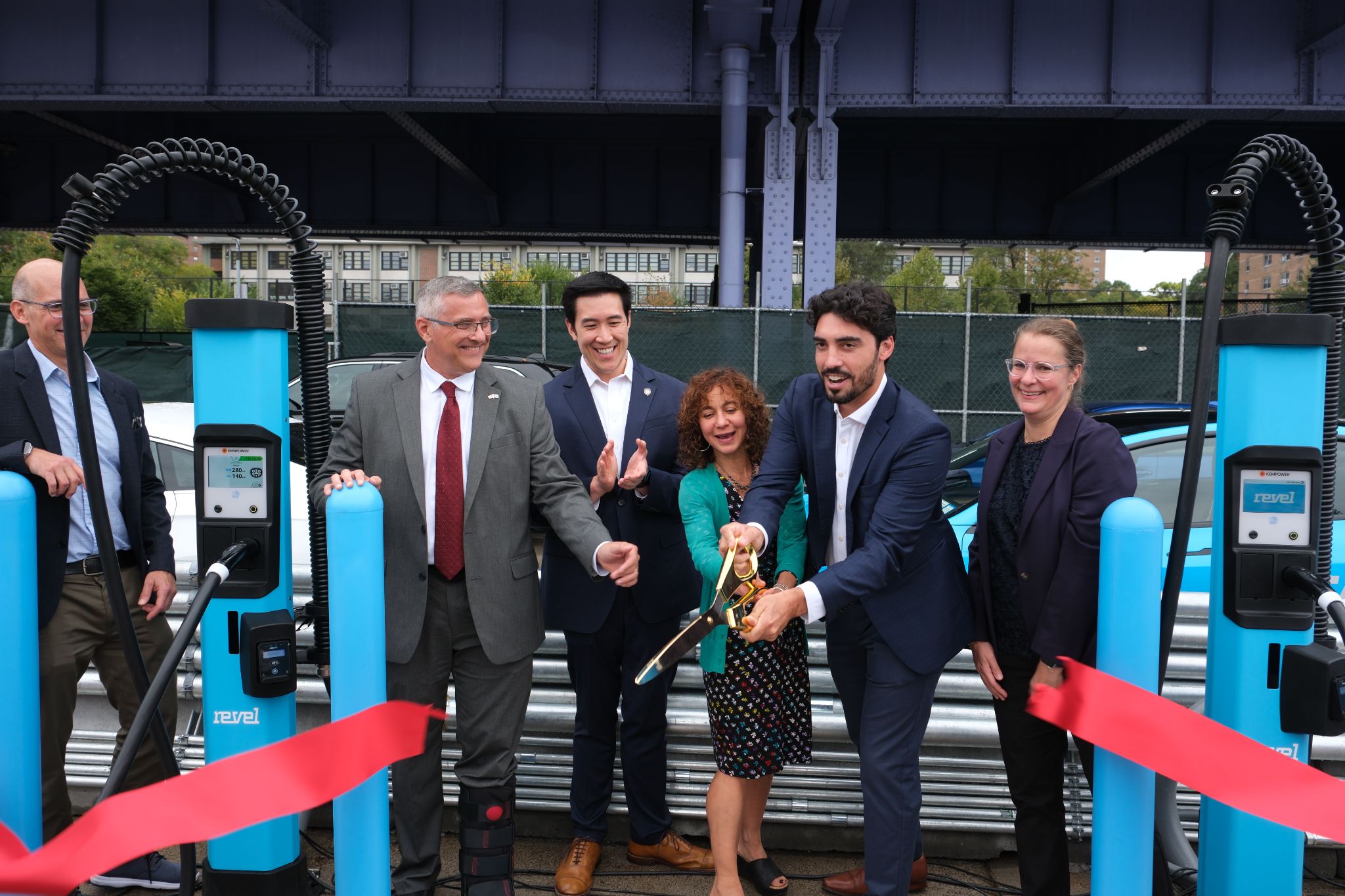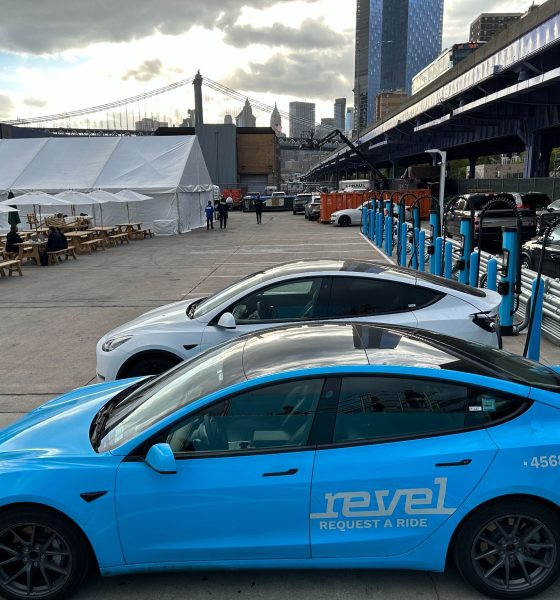Revel has opened its first-ever fast-charging electric vehicle station in Manhattan at Pier 36 on the Lower East Side.
This is the first fully public, 24/7 EV charging station in Manhattan, which has been a major challenge for companies and individuals utilizing EVs due to very limited real estate.
Revel developed the site with New York City’s Economic Development Corporation (NYCEDC). The site features 10 320 kW chargers made by Kempower.
The big challenge with EV ownership when living in New York City is access to public chargers.
While Revel, Tesla, and others are operating charging infrastructure in various boroughs like Queens and Brooklyn, Manhattan is so limited on space that those who utilize EVs for personal use or ride-sharing truly struggle for options.

Frank Reig, Revel’s Co-Founder and CEO, said:
“Hundreds of thousands of rideshare and taxi trips go in and out of Manhattan every day. With our new Pier 36 Charging Station, Revel is bringing the fastest charging on the market directly to those drivers so they can access EVs easier — saving them money and saving us all from breathing in more needless car pollution…This is Revel’s first in the borough, but definitely not our last!”
Revel has had this new station at Pier 36 in the works for some time. Last year, they hinted during an interview with me that they were working on something in Manhattan. It’s finally here.
This station brings Revel’s total network to 64 public fast chargers across the five boroughs of New York City. Their plans are to expand rapidly, hoping to have 300 active chargers by the end of 2025.
The significance of this station being in Manhattan was recognized by several figures:
State Senator Brian Kavanagh:
“The introduction of this first 24/7 public fast charging station in Manhattan represents a pivotal step in our journey toward a zero-emission transportation network. With the busy flow of rideshare and taxi traffic in and out of Manhattan, providing the fastest charging options directly to drivers not only saves them money but also helps us all breathe a little easier by reducing harmful car pollution.”
NYCEDC President and CEO Andrew Kimball:
“The opening of Revel’s first Manhattan charging station will help New York City become an innovator in accelerating low-carbon alternatives in the transportation sector, spark cutting-edge innovation that will unlock solutions for the global climate crisis, and create new economic opportunity for the city.”
Assemblymember Grace Lee:
“By expanding access to high-speed EV chargers in Lower Manhattan, we are not only promoting green technology but also reducing harmful emissions and improving air quality for our community. This is a crucial investment in the health and well-being of Lower Manhattan, and I look forward to continuing to support initiatives that advance our city’s environmental goals.”
Deputy Mayor for Operations Meera Joshi:
“New York is charging ahead! If we want to meaningfully reduce emissions, more cars will need to plug, rather than chug. But modal shifts will only happen once there’s the infrastructure to support it. Along with our 80,000-strong for-hire vehicle fleet’s transition to electric, the first 24/7 charger in Manhattan is a strong indicator of what’s to come. Thanks to Revel, EDC, DOT and all our partners for this Climate Week milestone. In partnership with the private sector, government continues to deliver for New Yorkers.”
Revel’s expanding number of EV fast chargers will support the evergrowing number of drivers utilizing sustainable powertrains for ride-sharing purposes. The New York City Taxi & Limousine Commission issued approximately 10,000 new licenses for electric-for-hire vehicles in October 2023.
This has brought the share of EV trips to over 10 percent of the total rideshare volume, or approximately 1.5 million rides per month.
I’d love to hear from you! If you have any comments, concerns, or questions, please email me at joey@teslarati.com. You can also reach me on Twitter @KlenderJoey, or if you have news tips, you can email us at tips@teslarati.com.

News
Tesla aims to combat common Full Self-Driving problem with new patent
Tesla writes in the patent that its autonomous and semi-autonomous vehicles are heavily reliant on camera systems to navigate and interact with their environment.

Tesla is aiming to combat a common Full Self-Driving problem with a new patent.
One issue with Tesla’s vision-based approach is that sunlight glare can become a troublesome element of everyday travel. Full Self-Driving is certainly an amazing technology, but there are still things Tesla is aiming to figure out with its development.
Unfortunately, it is extremely difficult to get around this issue, and even humans need ways to combat it when they’re driving, as we commonly use sunglasses or sun visors to give us better visibility.
Cameras obviously do not have these ways to fight sunglare, but a new patent Tesla recently had published aims to fight this through a “glare shield.”
Tesla writes in the patent that its autonomous and semi-autonomous vehicles are heavily reliant on camera systems to navigate and interact with their environment.

The ability to see surroundings is crucial for accurate performance, and glare is one element of interference that has yet to be confronted.
Tesla described the patent, which will utilize “a textured surface composed of an array of micro-cones, or cone-shaped formations, which serve to scatter incident light in various directions, thereby reducing glare and improving camera vision.”

The patent was first spotted by Not a Tesla App.
The design of the micro-cones is the first element of the puzzle to fight the excess glare. The patent says they are “optimized in size, angle, and orientation to minimize Total Hemispherical Reflectance (THR) and reflection penalty, enhancing the camera’s ability to accurately interpret visual data.”
Additionally, there is an electromechanical system for dynamic orientation adjustment, which will allow the micro-cones to move based on the angle of external light sources.
This is not the only thing Tesla is mulling to resolve issues with sunlight glare, as it has also worked on two other ways to combat the problem. One thing the company has discussed is a direct photon count.
CEO Elon Musk said during the Q2 Earnings Call:
“We use an approach which is direct photon count. When you see a processed image, so the image that goes from the sort of photon counter — the silicon photon counter — that then goes through a digital signal processor or image signal processor, that’s normally what happens. And then the image that you see looks all washed out, because if you point the camera at the sun, the post-processing of the photon counting washes things out.”
Future Hardware iterations, like Hardware 5 and Hardware 6, could also integrate better solutions for the sunglare issue, such as neutral density filters or heated lenses, aiming to solve glare more effectively.
Elon Musk
Delaware Supreme Court reinstates Elon Musk’s 2018 Tesla CEO pay package
The unanimous decision criticized the prior total rescission as “improper and inequitable,” arguing that it left Musk uncompensated for six years of transformative leadership at Tesla.

The Delaware Supreme Court has overturned a lower court ruling, reinstating Elon Musk’s 2018 compensation package originally valued at $56 billion but now worth approximately $139 billion due to Tesla’s soaring stock price.
The unanimous decision criticized the prior total rescission as “improper and inequitable,” arguing that it left Musk uncompensated for six years of transformative leadership at Tesla. Musk quickly celebrated the outcome on X, stating that he felt “vindicated.” He also shared his gratitude to TSLA shareholders.
Delaware Supreme Court makes a decision
In a 49-page ruling Friday, the Delaware Supreme Court reversed Chancellor Kathaleen McCormick’s 2024 decision that voided the 2018 package over alleged board conflicts and inadequate shareholder disclosures. The high court acknowledged varying views on liability but agreed rescission was excessive, stating it “leaves Musk uncompensated for his time and efforts over a period of six years.”
The 2018 plan granted Musk options on about 304 million shares upon hitting aggressive milestones, all of which were achieved ahead of time. Shareholders overwhelmingly approved it initially in 2018 and ratified it once again in 2024 after the Delaware lower court struck it down. The case against Musk’s 2018 pay package was filed by plaintiff Richard Tornetta, who held just nine shares when the compensation plan was approved.
A hard-fought victory
As noted in a Reuters report, Tesla’s win avoids a potential $26 billion earnings hit from replacing the award at current prices. Tesla, now Texas-incorporated, had hedged with interim plans, including a November 2025 shareholder-approved package potentially worth $878 billion tied to Robotaxi and Optimus goals and other extremely aggressive operational milestones.
The saga surrounding Elon Musk’s 2018 pay package ultimately damaged Delaware’s corporate appeal, prompting a number of high-profile firms, such as Dropbox, Roblox, Trade Desk, and Coinbase, to follow Tesla’s exodus out of the state. What added more fuel to the issue was the fact that Tornetta’s legal team, following the lower court’s 2024 decision, demanded a fee request of more than $5.1 billion worth of TSLA stock, which was equal to an hourly rate of over $200,000.
Delaware Supreme Court Elon Musk 2018 Pay Package by Simon Alvarez
News
Tesla Cybercab tests are going on overdrive with production-ready units
Tesla is ramping its real-world tests of the Cybercab, with multiple sightings of the vehicle being reported across social media this week.

Tesla is ramping its real-world tests of the Cybercab, with multiple sightings of the autonomous two-seater being reported across social media this week. Based on videos of the vehicle that have been shared online, it appears that Cybercab tests are underway across multiple states.
Recent Cybercab sightings
Reports of Cybercab tests have ramped this week, with a vehicle that looked like a production-ready prototype being spotted at Apple’s Visitor Center in California. The vehicle in this sighting was interesting as it was equipped with a steering wheel. The vehicle also featured some changes to the design of its brake lights.
The Cybercab was also filmed testing at the Fremont factory’s test track, which also seemed to involve a vehicle that looked production-ready. This also seemed to be the case for a Cybercab that was spotted in Austin, Texas, which happened to be undergoing real-world tests. Overall, these sightings suggest that Cybercab testing is fully underway, and the vehicle is really moving towards production.
Production design all but finalized?
Recently, a near-production-ready Cybercab was showcased at Tesla’s Santana Row showroom in San Jose. The vehicle was equipped with frameless windows, dual windshield wipers, powered butterfly door struts, an extended front splitter, an updated lightbar, new wheel covers, and a license plate bracket. Interior updates include redesigned dash/door panels, refined seats with center cupholders, updated carpet, and what appeared to be improved legroom.
There seems to be a pretty good chance that the Cybercab’s design has been all but finalized, at least considering Elon Musk’s comments at the 2025 Annual Shareholder Meeting. During the event, Musk confirmed that the vehicle will enter production around April 2026, and its production targets will be quite ambitious.










